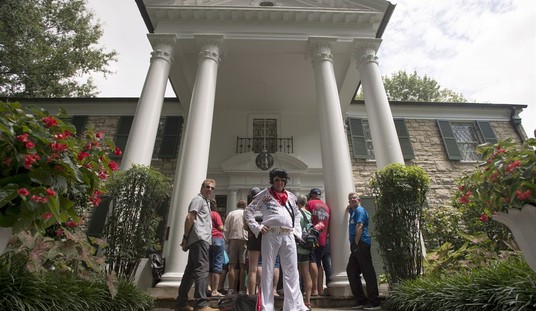The media has slaughtered forests of trees and dedicated quintillions of pixels to the question of whether Trump voters will remain loyal to him. The Washington Post provides an answer, or at least some data which suggests one. According to its own analysis and another at the center-left Brookings Institute, blue-collar jobs have expanded at a faster rate than at any time since Ronald Reagan’s first term in office:
Blue-collar jobs are growing at their fastest rate in more than 30 years, helping fuel a hiring boom in many small towns and rural areas that are strong supporters of President Trump ahead of November’s midterm elections.
Jobs in goods-producing industries — mining, construction and manufacturing — grew 3.3 percent in the year preceding July, the best rate since 1984, according to a Washington Post analysis. …
Rural employment grew at an annualized rate of 5.1 percent in the first quarter. Smaller metro areas grew 5 percent. That’s significantly larger than the 4.1 percent growth seen in large urban areas that recovered earlier from the Great Recession, according to an analysis by the Brookings Institution’s Metropolitan Policy Program of a separate set of Labor Department data released Wednesday.
In the past year, the economy has added 656,000 blue-collar jobs, compared with 1.7 million added in the services sector. But the rate of growth in blue-collar jobs is speeding up, while service-sector job growth has hovered around 1.3 percent over the past year.
Brookings delves a little deeper into the data:
To be more specific, while information-sector growth has turned negative in the last two years (with a slight recovery starting in 2018), resource extraction and manufacturing industries have been growing at their fastest rates since the financial crisis. Mining and logging pursuits (which include oil and gas extraction) have seen rapid employment growth based on strong hiring in the various support activities associated with the sector like exploration and prospecting. Meanwhile, machinery manufacturing; electrical equipment, appliance, and component manufacturing; and fabricated metal product manufacturing have all been growing smartly as domestic demand has kept factories humming.
These patterns are notable for what they say about the contours of national economic activity but also because they reflect what’s happening on the ground, in particular urban and rural areas. And in this regard, the dynamics of the current economic surge—strong goods production and relatively weaker services provision—slightly disfavor larger, bluer, tech- and service-oriented metros, and relatively favor smaller, more rural, and redder communities by comparison to their recent problems. This conclusion aligns with the findings of smart analysts like Jed Kolko of Indeed. And it suggests that growth patterns are now playing out fairly positively for many if not all smaller communities and rural areas.
Why did people in the Rust Belt and Midwest vote overwhelmingly for Trump? For one thing, Hillary Clinton ignored them, but they had been swinging toward Trump already in large part because they felt left out of the economic growth that had centered in the cities over the past decade. That anger and frustration really only found its voice in Trump in the 2016 cycle; even Bernie Sanders’ populism focused on Academia and the urban cores rather than the suburbs, exurbs, and rural areas.
So far, the Trump administration has largely delivered on those frustrations. The tax cuts and corporate tax reforms brought a lot of cash back into the US and incentivized investment in manufacturing. The trade wars Trump launched was an effort to reverse the damage done to manufacturing areas of the country, and it might succeed, especially with the new NAFTA guidelines to which Mexico has agreed in principle. As the data shows, it’s already brought jobs back to areas which haven’t seen much growth in more than a generation.
This is why these voters went all-in for Trump, and why they’re not likely to peel away. It had little to do with ancient ethno-cultural resentments, which is how most media outside of these areas framed it, but with solid economic concerns built up over four decades of failure. These voters didn’t benefit from the expansion in the 1990s and the expansion after the Great Recession and got tired of being left behind. Now that they have had a taste of success with Trump, they are not likely to throw in the towel in 2020, even if the Democratic challenger doesn’t repeat Hillary’s mistakes.
The Post wonders if it can last:
The good times may not last. Some economists warn that the long-term trends still favor big cities and digitally focused industries. There are signs that growth may be tapering off in some blue-collar sectors: Home sales have cooled this summer, and manufacturers fear that Trump’s trade war will erase their competitive edge.
This is the message that Republicans should be pushing every day between now and the midterm elections. Reversing the policies that brought this growth to these voters will put an early end to it, such as hiking taxes and undoing the corporate tax reforms, both of which Democrats insist they will do once back in power. It’s tough to motivate happy voters to turn out in elections, but these successes are not guaranteed to last under progressive policies. The issue isn’t brand loyalty as much as it is pocketbooks, and these voters suddenly do have something to lose. And they should know it better than most.
Addendum: What the media has missed most about the blue-collar sector is their satisfaction when job growth is reasonable. Be sure to read Salena Zito’s latest on this point at the Washington Examiner.







Join the conversation as a VIP Member